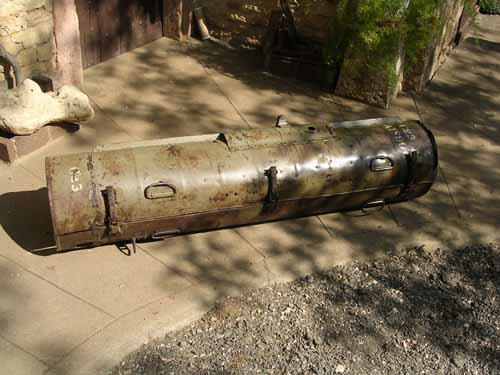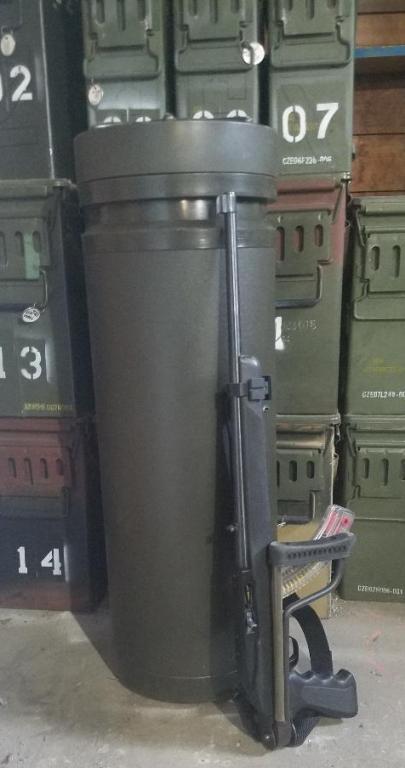I was puttering around in the basement moving some stuff around and one of the things stacked in the corner with the ‘this pile is for the secondary location’ is a couple of Monovaults.
I had done a lengthy post on the Monovault back in 2013 but when the website crashed I lost about a years worth of posts and that was one of them. A shame too, because it was actually a pretty informative post about what I thought was a very good product. So much so, in fact, that I’m going to go through the tremendous pain in the butt of retaking the pictures and reposting about it.
Succinctly, the Monovault is a large diameter plastic tube designed for storing (and burying) whatever items you feel need to be tucked away somewhere. The tubes have a Gamma Seal lid closure at one end, and then a ‘burial cap’ that goes over that to make retrieval easier. The tubes come in several different lengths and diameters depending on what it is that you want to tuck away.
Remember those cylindrical weapons/supply containers from WW2 that we’d see in movies? It’s pretty much a very modernized version of that.

WW2-era airborne supply drop tube. These things still turn up once in a while when someone treks out into the dense forests and swamps over in Europe.
Purpose? Nominally, they are sold as burial vaults for whatever it is that you feel needs to be buried. And, that makes sense. But I’m a bit of an outside-the-box kind of guy and while I’m sure these would work just fine for burial, to me they are more of an ideal cache container. While burying is certainly an option, the qualities that make a container suitable for burying (waterproof, airtight, durable,etc.) also make them perfect for enplacing in above-ground environments – hidden in attics, under porches, buried in brush piles, sitting in the corner of the basement, under the gravel pile on the back forty, etc.
I wound up with two versions of the Monovault which were supplied to me by the fine folks there. (We actually did a bit of trading back and forth.) Being me, I wanted the biggest one they had (the #248) and a midling sized one – the #130.

The #130. Fits a folding 10/22, a daypack, boots, water, food, radio, flashlight, batteries, and a few other things that might make a big difference to you when you discover that your world has suddenly taken a turn for the sideways.

Gamma Seal lid and ‘burial lid’ cover. Still enough room in there to pack the essentials that would give you several orders of advantage over the rest of the herd. Pack wisely.
The #130 seems like the perfect size for the “I want to keep some essentials around in case I have to leave in a hurry”. A folding (or takedown) 10/22 will fit in there [as will the new takedown Ruger 9mm carbine] along with a frameless medium ALICE pack (or your favorite daypack), along with room for comfortable shoes, a jacket, radio, pistol, water, and a few other goodies. If you were stuck in an office building on 9/11 and had to walk your way out of Manhattan, one of these would have held pretty much just what you needed – water, shoes, radio, flashlight, weapon of choice, and that sort of thing.
The #248 is where the real action comes into play. Large enough that hauling one full of gear to a burial or cache sight might be a two-man job, it’ll hold everything you need to get your immediate life back on the rails. A full size rifle like a 20″ AR or HK .308 will fit inside with no dificulty. If you pack a smaller or broken down rifle in there, theres room for a backpack, military sleep system, freeze drieds, and a bunch of other gear. My checklist for packing for this sort of thing is ‘it’s the middle of winter, dead of night, and I’m dropped naked in the middle of nowhere. What do I need right now?’. However, if you want to have a bundle of gear dedicated to a particular purpose….exclusively gunstuff, exclusively food and water, exclusively gear, etc, these things would be good choices for that.

Big enough to handle the larger rifles. When you’re done filling this thing up, it’ll be heavy so plan accordingly.
Although I use a large Pelican case for storing my winter vehicle gear, one of these would make an excellent container for that task. Especially since you could just leave it in the bed of your truck (secured, of course) and it’d be impervious to snow and wet. Also, it’s long cylindrical nature lets it take up less room.
For storing guns I prefer the Pelican rifle cases. They’re very good at that job and, as you might expect, theyre also fairly expensive. Problem is, unless you get into the really specialty Pelican cases (which are even spendier) you can’t really stuff a goodly amount of gear in a Pelican case along with your rifle. The Monovault lets you do exactly that. In fact, if I were storing some gear hidden away at the Beta Site I’d probably tuck the guns in Pelican cases and the gear in the Monovault. (Although, if I wanted an all-in-one solution it would all, gear and rifle, go in the Monovault.)
Pricing is about comparable to what you’d pay for a Pelican case, so it’s not too outrageous. Like a Pelican case, the annoying part is paying the shipping for a large bulky item.But…when it’s 2am, the snow is coming down, and you finally bring your exhausted vehicle to a stop at your bugout location what’s it worth to know that your food, guns, radios, camp stove, and winter gear are all dry and clean tucked away under the floorboards waiting for you?

Another great post, thank you.
Good stuff. Really not sure I could afford something like that….:-(
I know this sucks, but my ‘solution’ is used 55 gallon HDPE food-safe barrels ($20 each). Everything needs to be (at least) double, and preferably triple wrapped, screw cap epoxied shut & sealed with silicon. Basically have to destroy the thing to get it open, but it works for me.
Tim
That is a value storage solution. No need to be embarrassed about your set up. It works. I have a couple 55 gallon food barrels at my remote location and they are impervious to outside elements. But they are bulky no doubt. Every prepper chooses what solutions he can with what he has.
I was a late arrival to the AR pistol party. Just didn’t see the utility. Now? You have shown us another place in which an AR pistol would shine. Especially with a Law Tactical folding stock adapter.
Thanks for posting this. With everything going on up here in the Great White North, I’ve been looking for a BATF* solution. This looks to be a heck of a lot better than using big PVC pipe.
* Bury All The Firearms.
What’s the downside of a big pvc pipe? It is just as sturdy and a lot cheaper.
Can you periodically non-destructively open the PVC pipe to inspect or replace materiel? And when you get to PVC pipe of a comparable diameter is the price any different?
Only with properly greased cleanout plugs, which have to be covered (an up-ended 5-gal plastic bucket works there).
The MTMs are simpler and easier solution to that problem, and finding larger-diameter PVC hereabouts is somewhat problematic.
And re: a cache at all:
Eggs.
Basket.
Have many.
My plan for caches is to plant several smaller ones co-located around a central point, sorted by category, rather than one single jackpot for some clown trespassing with a metal detector. (And they’re a thing, everywhere.)
If you’ve got more than one cache, standardize the layout.
Maybe you only need food, or a weapon, or whatever, so while you have to bury multiple smaller containers initially, you would only need to unbury the ones you needed, on the day, leaving the rest undisturbed for another time. And simultaneously making harder for others to find all your goodies with one strike.
I also figure anyone serious would know they won’t be bugging in nor out, but rather more likely, through the nearby areas, with some regularity.
Back in the day, when we planned multi-day large group backpacking trips, we pre-cached water and food resupply at a couple of places to cut down on having to hump 10 days of water and grub through SoCal deserts.
The same thing would work for patrols, whether moving permanently, or just scouting around and hunting, provided whatever’s buried is animal-proof for the animals in the target area. Harder to do for Mr Griz, but simple enough for Wile E. Coyote.
Just another way to skin that cat.
One other thing:
For any longer PVC or the longest MTM tubes buried vertically, you should probably either make a full diameter cloth (nylon/poly is better than cotton, because it doesn’t hold as much moisture) case with reinforced bottom and pull handles to retrieve everything, or else precut a piece of 1/2″ or 3/4″ plywood to fit snugly, and tie a stout length of indestructible nylon dock line, knotted beyond the wood disc, with the pulling end on top of everything else, so once your cache is open, you can pull everything to the surface.
Unless you have 4′ gorilla arms, it’s a lot easier than reaching to the bottom, which is invariably where the one item you wanted ends up.
Your background items in your pics prove you’re a real preparedness man. And I love it. Great post
J lope
I have 2 AR pistols. One in .300 BLK. ( not really sure why as it sort of a pain to reload for ) . But the idea is compactness. I don’t care for any long type weapon, even in hunting. Short means easy storage and movement in confined spaces. What you lose ballistically is very little. Try manipulating a 24 inch barreled weapon in a vehicle to the opposite side window for suppressive or return fire. In the tight brush hunting the 18 or even 16inch .308 ( or .30-30, or whatever ) is very quick to get on a deer you just busted up. And transportation in smaller cases in your vehicle is a lot easier. That’s my .2 cents anyway.
In the state of Washington, a loaded AR pistol on the car is okay if you have a CPL. Not so with a loaded rifle. Big trouble, actually.